Wine Lister’s partner critic platform, JancisRobinson.com has now released the majority of its scores for the 2020 vintage, helping to paint a better picture of some of the top en primeur picks.
Explore all Bordeaux 2020 scores here, or read more below.
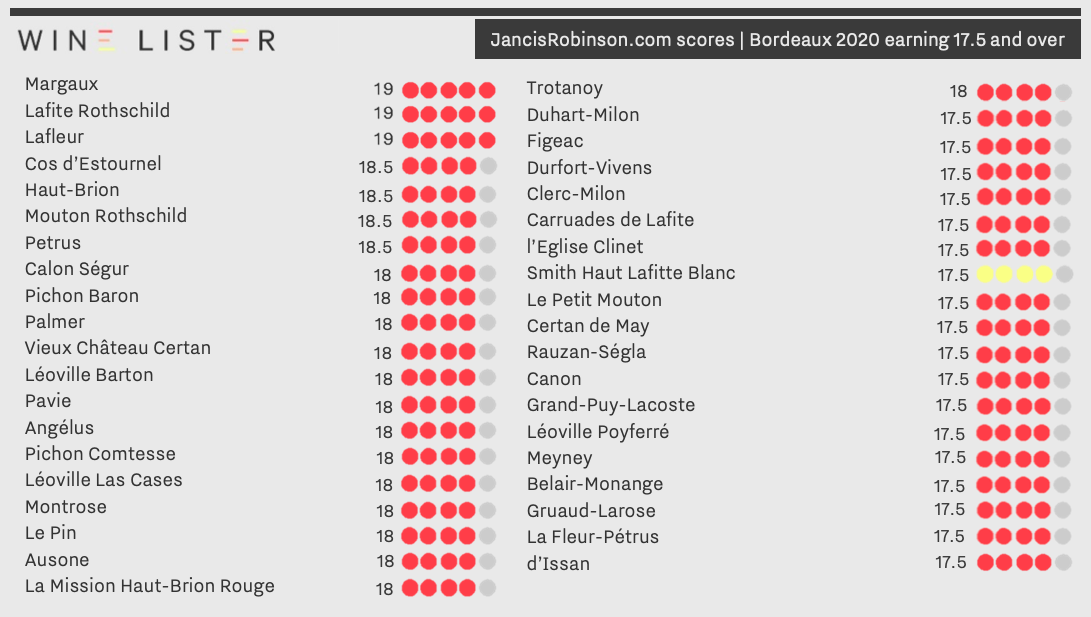
With a shared score of 19 from James Lawther for JancisRobinson.com, First Growths Margaux and Lafite lead the pack alongside Pomerol’s beloved Lafleur. Lawther describes Margaux 2020 as “aromatically complex with floral, mineral and dark-fruit notes”, and notes that Lafite 2020 is “rich, but with a massive charge of fine-grained tannin and lingering freshness” on the palate.
Fellow First Growths Haut-Brion and Mouton follow shortly after with a score of 18.5, shared with Lafleur’s neighbouring property, Petrus, and Saint-Estèphe staple, Cos d’Estournel.
Pomerol represents eight out of the 39 wines earning 17.5 and over from the JancisRobinson.com critics, recalling sentiments that earlier-ripening Merlots fared best in the latest vintage. Joining Lafleur and Petrus, Vieux Château Certan, Le Pin, Trotanoy, l’Eglise Clinet, Certan de May, and La Fleur-Pétrus earn a score of 17.5 for their 2020s.
Smith Haut Lafitte Blanc is the only dry white Bordeaux to gain a score of 17.5 and above from JancisRobinson.com critics so far. Robinson tasted the wine herself, and observes that it is “already gorgeous” with “some richness on palate entry” that “gives way to really fantastic vibrancy on the palate”.
Also featured in the list of Bordeaux 2020s earning 17.5 and over from Wine Lister partner critic platform, JancisRobinson.com are: Calon Ségur, Pichon Baron, Palmer, Léoville Barton, Pavie, Angélus, Pichon Comtesse, Léoville Las Cases, Montrose, Ausone, La Mission Haut-Brion Rouge, Trotanoy, Duhart-Milon, Figeac, Durfort-Vivens, Clerc-Milon, Carruades de Lafite, Le Petit Mouton, Rauzan-Ségla, Canon, Grand-Puy-Lacoste, Léoville Poyferré, Meyney, Belair-Monange, Gruaud-Larose, and d’Issan.
Explore the top Bordeaux 2020 scores from Bettane+Desseauve, Neal Martin and Antonio Galloni (Vinous), and Jeannie Cho Lee.
The majority of Bordeaux 2020 en primeur scores have now been published by Wine Lister partner critic, Bettane+Desseauve, offering further insight into some of the best bottles from the latest vintage.
Explore all Bordeaux 2020 WL scores here, or read more below.
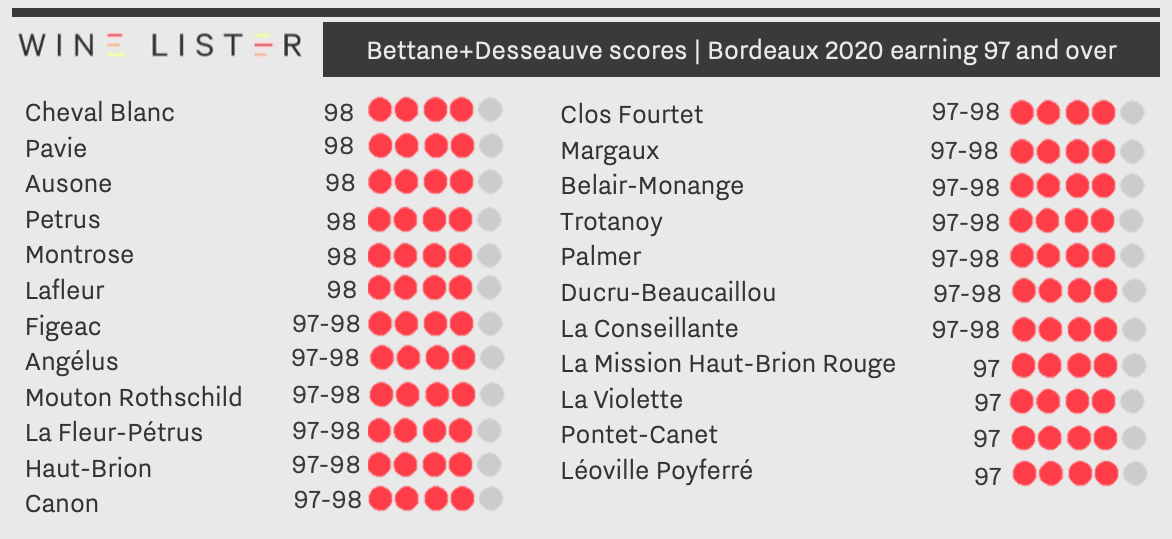 Note that this year Bettane+Desseauve’s scores are officially ranked on a 100-point scale, as shown above. For consistent and comparable analysis with previous vintages, Bettane+Desseauve have provided 20-point scores to be displayed on individual Wine Lister wine pages during the transition into their new system.
Note that this year Bettane+Desseauve’s scores are officially ranked on a 100-point scale, as shown above. For consistent and comparable analysis with previous vintages, Bettane+Desseauve have provided 20-point scores to be displayed on individual Wine Lister wine pages during the transition into their new system.
Five of the six wines that receive a score of 98 from Bettane+ Desseauve this year hail from the Right Bank, with Cheval Blanc, Pavie, Ausone, Petrus, and Lafleur leading the list. This adheres to initial indications that it is a Right Bank year, with earlier-ripening Merlot, partnered with the soil’s increased water-holding capacity, helping it handle the drought during the summer.
Indeed, a further five wines on the list come from Saint-Emilion, whose limestone terroirs encouraged a steady water table for the vines in 2020. Figeac, Angélus, Canon, Clos Fourtet, and Belair-Monange all score an impressive 97.5 with their latest vintages.
Pomerol also provides a further four picks, with La Fleur-Pétrus, Trotanoy, and La Conseillante gaining 97.5, followed by micro-production La Violette (releasing 4,800 bottles in 2020) with 97 points.
Also featured on the list of Bordeaux 2020s earning 97 and over from Wine Lister partner critic, Bettane+Desseauve are: Mouton Rothschild, La Fleur-Pétrus, Haut-Brion, Margaux, Palmer, Ducru-Beaucaillou, La Mission Haut-Brion, Pontet-Canet, and Léoville Poyferré.
Explore the top Bordeaux 2020 scores from JancisRobinson.com, Neal Martin and Antonio Galloni (Vinous), and Jeannie Cho Lee.
As another week of Bordeaux 2020 en primeur releases draws to a close, the campaign has begun to show signs of speeding up, with some compelling releases entering the market over the past three days.
Below we examine releases from Laroque (Wednesday 19th), Lafon-Rochet (Thursday 20th), and Branaire-Ducru and Batailley (Friday 21st).
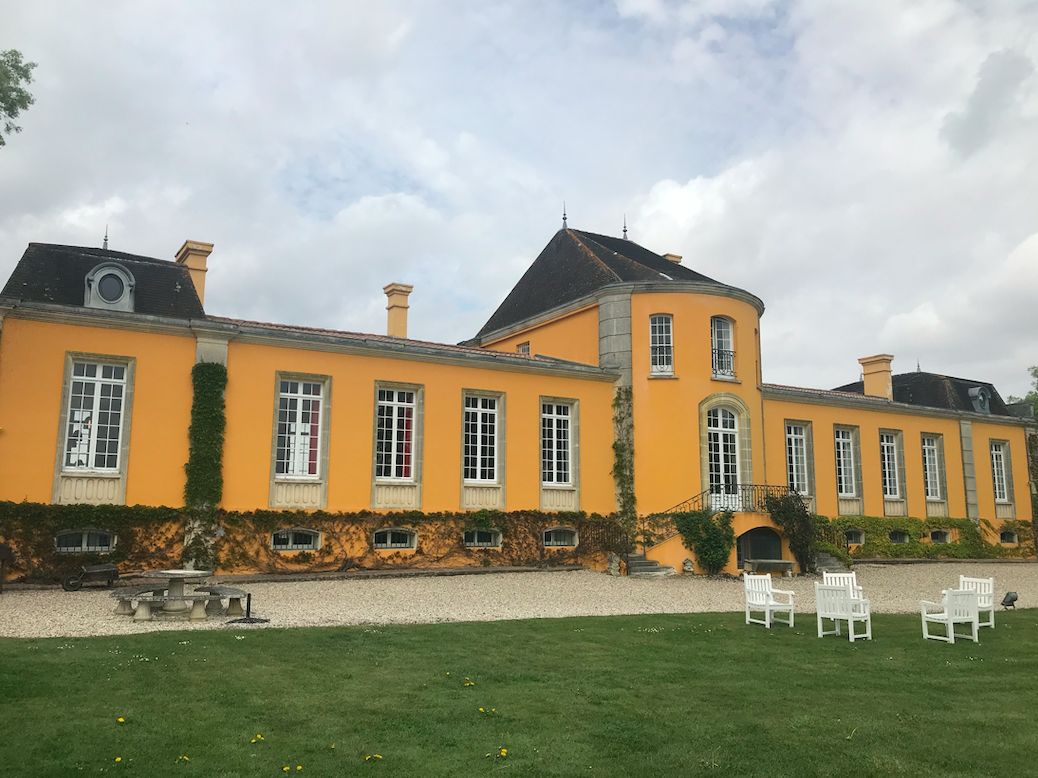 Lafon-Rochet’s latest release is a “very successful 2020”, according to Wine Lister partner critic, Jancis Robinson
Lafon-Rochet’s latest release is a “very successful 2020”, according to Wine Lister partner critic, Jancis Robinson
Released at £18.95 per bottle (in-bond), Laroque was described by Wine Lister CEO, Ella Lister as having an “ebullient, classy, very cassis nose”, developing into a “serious, structured wine on the palate”. The estate has seen recent improvements and investments to achieve a higher quality, starting with the hiring of David Suire in 2015, and the 2020 is no exception in the recent pattern of excellent value for money.
Lafon-Rochet’s latest vintage also illustrates the property’s upward quality trajectory. Having been awarded 17 points from Wine Lister partner critic, Jancis Robinson, (up from 16.5+ for the 2019) she describes it as a “very successful 2020” and congratulates owner, Basile Tesseron, for “producing something so appetising and groundbreaking”. Entering the market yesterday at c.£27.10 per bottle (in-bond), the vintage marks a year of development at Lafon-Rochet. As well as embarking on an agroforestry scheme in 2020 to enrich its environment, the latest release marks the inaugural collaboration of Jean-Claude Berrouet and Eric Boissenot, who worked together on its blending (recap our blog here). The price positioning of this top-quality vintage 10% below the 2019 market price has reportedly been very well-received.
Cru Classés Branaire-Ducru and Batailley were released this morning. Having made a name for itself as offering exceptionally good value within the Saint-Julien appellation, Branaire-Ducru’s latest release (at £31 per bottle in-bond) enters the market at an average 11% and 22% below than current availability of the 2019 and 2018 respectively.
Writing for JancisRobinson.com, James Lawther awards Batailley 2020 17 points, describing it as “Solid, subdued and distinctly Pauillac”. At c.£28 per bottle (in-bond), it enters the market under current average market prices of the last six vintages.
Keep track of en primeur releases on Wine Lister’s dedicated En Primeur Page here.
With the bank holiday weekend approaching, Wine Lister has selected 10 mature Bordeaux MUST BUYs that promise to please with your Easter Sunday lunch. Boasting at least nine years of ageing, these top picks are available to purchase for under £100 (per bottle in-bond, when purchasing by the case in general).
Check out all of our Bordeaux MUST BUYs here, or read more below.
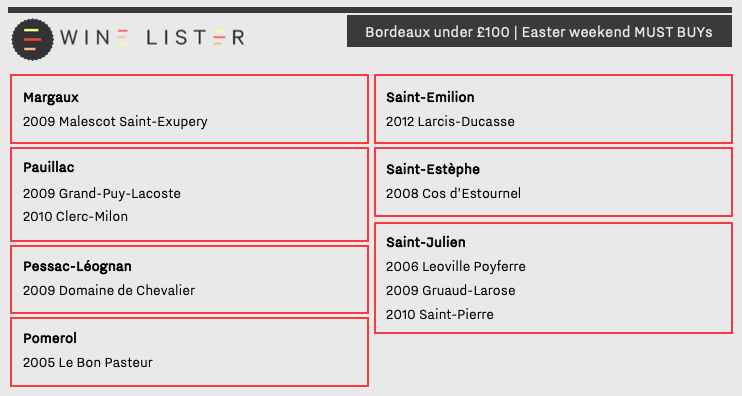
Regarded as a top-quality year for Bordeaux across appellations four of the 10 MUST BUY picks hail from 2009. Following a wet spring that provided plentiful water reserves, the summer of 2009 saw almost perfect growing conditions with minimal disease pressure, and many great wines from the vintage are beginning to either their optimum drinking window.
Described by Wine Lister partner critic, Jancis Robinson, as “very winning and opulent” with “massive volume and finish”, Margaux’s Malescot Saint-Exupery achieves a WL score of 93 in 2009. The property has exhibited an upward quality trajectory since the turn of the century, with the legendary Michel Rolland consulting on its production of a single, unfiltered and unfined wine. The 2009 vintage can be purchased from Fine+Rare for £71 per bottle (in-bond).
Grand-Puy-Lacoste’s 2009 vintage receives 18 points from Robinson, who notes; “a very sweet start. Herbal and interesting. Lots of fine tannin and savour. Very distinctive and ambitious”. Marking the estate’s highest WL score since its 1990 vintage (94), the 2009 is available to purchase from Bordeaux Index for £59 per bottle (in-bond).
Another classic left bank brand, Gruaud-Larose’s 2009 is described by Wine Lister partner critic, Neal Martin (Vinous), as offering refined aromas of “blackberry, cedar and leather”, and a “fine bead of acidity [with] great precision on the brown spice infused finish”. Hailed for the longevity of its wines, this can be enjoyed now, or aged for at least 10 more years. It is available from Bordeaux Index for £81 per bottle (in-bond).
Moving across to the right bank and back a few vintages, 2005 Le Bon Pasteur achieves the property’s highest ever WL score (94), and is described by Wine Lister partner critic, Bettane+Desseauve as offering notes of “dark fruits and fine chocolate”, and a “refined tannic structure, brilliant length and freshness”. With over 15 years of age, and only 2,500 bottles released, it has limited remaining market availability, but can be sought out for £100 per bottle (in-bond) from Cru World Wine.
Slightly south in Saint-Émilion, our chosen younger offering from Larcis-Ducasse – the 2012 – is available from Cult Wines for £41 per bottle (in-bond), making it the least expensive of the group. While rain in October forced many left bank estates to pick their late-ripening Cabernet Sauvignon earlier, the predominance of Merlot on the right bank saw its wines perform comparably better in 2012. Wine Lister partner critic, Jeannie Cho Lee, describes the 2012 Larcis-Ducasse as an “elegant, full bodied red with opulent tannins and wonderful energy”.
Last but not least, Saint-Estèphe star Cos d’Estournel makes the cut for its 2008 vintage. Robinson describes it as “very luscious and round” with a “strong blackcurrant element” and “surprisingly gentle tannins”. Achieving a WL score of 94, it is available to purchase by the bottle from Lay & Wheeler for £88 (in-bond).
To mark the first day of spring (Saturday 20th March), this week’s blog takes a deep dive into Wine Lister’s latest MUST BUY update, helping you to discover some excellent wines to enjoy over the next few months. The 19 new MUST BUYs cover a range of regions, varieties, and styles, providing inspiration for top picks to drink now or put away for the future.
Click here to view all MUST BUYs, or read more below.
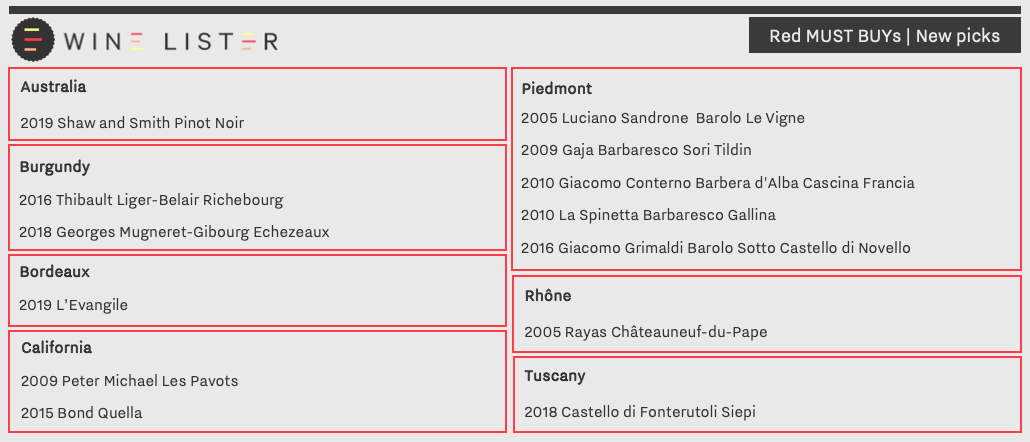
Piedmont constitutes over a quarter of the new MUST BUY picks, with entries from five of the region’s leading producers. Currently at its peak drinking, Luciano Sandrone’s 2005 Barolo Le Vigne comprises a blend of fruit from four of the estate’s top vineyards, each with different terroirs, altitudes, and exposures. Harvested, vinified, and aged separately, the final assemblage is intended to express the best characteristics of each plot. Wine Lister’s partner critic, Jancis Robinson, describes it as “complex”, with “already very integrated aromas”. It can be purchased from Farr Vintners for £79 per bottle (in-bond).
In Burgundy, Thibault Liger-Belair’s 2018 Richebourg achieves its highest WL score since the successful 2010 vintage (96), and is described by Wine Lister’s Burgundy specialist critic, Jasper Morris, as possibly “[Thibault’s] best Richebourg to date”. Awarding it 95-98 points, Jasper notes that “the oak […] is so suffused by a brilliant dense entirely red fruit, soft strawberry and more pronounced raspberry”. It is available to buy from Corney & Barrow for £450 per bottle (in-bond).
Representing the Southern Hemisphere, Shaw and Smith’s 2019 Pinot Noir also has Value Pick status, with a WL score of 92 at £26 per bottle (in-bond). The first vintage to include fruit from the property’s Lenswood vineyard, which boasts mature vines and high altitude, it marks an exciting development for Shaw and Smith. Richard Hemming for Jancis Robinson describes it at “superbly fragrant” and representative of “the sheer pleasure of the variety”. It can be bought from The Fine Wine Company.

Pierre-Yves Colin-Morey makes up two of three Burgundy whites to feature in the latest MUST BUY update, with its 2016 Meursault Perrières and 2018 Corton-Charlemagne. At £210 per bottle (in-bond), the former achieves 94 points from Jasper Morris, who notes “riper fruit, almost some orange blossom, but still an underlying freshness”. Meanwhile, Julia Harding for Jancis Robinson awards 19 points to the 2018 Corton-Charlemagne, describing it as “powerful and elegant” with a “smoky and quite subtle” nose. While both wines are more difficult to source, it is worth informing your merchant of your interest in purchasing them.
Other wines featured in the new MUST BUY selection are: 2005 Rayas Châteauneuf-du-Pape, 2009 Gaja Barbaresco Sori Tildin, 2009 Peter Michael Les Pavots, 2010 Giacomo Conterno Barbera d’Alba Cascina Francia, 2010 La Spinetta Barbaresco Gallina, 2014 Bouchard Père et Fils Montrachet, 2015 Bond Quella, 2016 Giacomo Grimaldi Barolo Sotto Castello di Novello, 2017 Gangloff Condrieu, 2017 Kistler Vineyards Hudson Vineyard Chardonnay, 2017 Kistler Vineyards McCrea Vineyard Chardonnay, 2018 Castello di Fonterutoli Siepi, 2018 Georges Mugneret-Gibourg Echezeaux, and 2019 l’Evangile.
Having commenced the week with International Women’s Day (Monday 8th March), Wine Lister’s latest blog celebrates some of the leading female figures in winemaking. Interviewing a handful of top producers across six regions, whose practices embody a range of principals, we put a spotlight on the wines made by some of the industry’s most exceptional women.
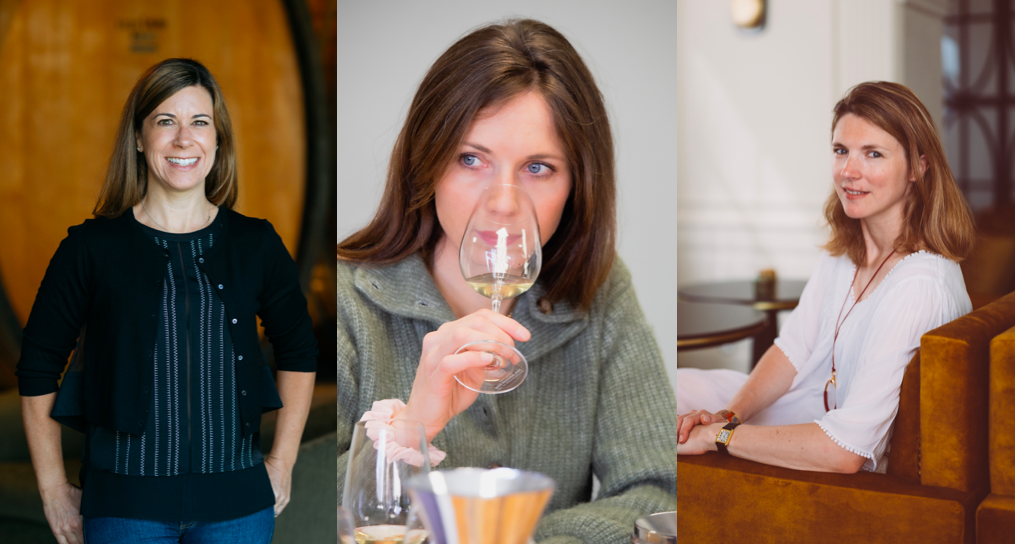 From left: Ashley Hepworth, Caroline Frey, and Stéphanie de Boüard-Rivoal
From left: Ashley Hepworth, Caroline Frey, and Stéphanie de Boüard-Rivoal
Ashley Hepworth – Joseph Phelps Vineyards
Following a degree in Chemistry and Biology, Ashley Hepworth spent two years cooking at Charlie Trotter’s legendary Chicago restaurant, where she realised she “wanted to learn more about wine and utilize [her] science background”. After studying the restaurant’s wines, and quizzing its Master Sommeliers, she applied for a harvest internship at Joseph Phelps where she continued to work her way “up the ladder”, eventually becoming winemaker in 2008. She is “particularly fond” of the 2008, 2015, and 2017 vintages of Joseph Phelps’ flagship wine, Insignia, explaining that each are “distinctive of the given vintage and the interplay of the six estate vineyards” that the wine is blended from.
Caroline Frey – La Lagune and Paul Jaboulet Aîné
Having taken the helm of third-growth property La Lagune from her father in 2004, Caroline Frey has since assumed an additional winemaking role in the Rhône, at Paul Jaboulet Aîné, after its acquisition by her family in 2005. Like several of the producers we spoke to, Caroline informs us that working “in harmony with nature is a long-term project” for her, with both properties now certified biodynamic. She explains that “to produce great wine the grapes must be the fruit of nature and not of synthetic chemistry”, and the more she “improves in working in harmony with nature” the “more wonderful” her wine will be.
Stéphanie de Boüard-Rivoal – Angélus
Having spent her childhood at Angélus, Stéphanie de Boüard-Rivoal was seven years old when she told her grandfather, Jacques de Boüard de Laforest, that she wanted to join him and her father, Hubert, in running the estate. After an early career in London’s financial sector, Stéphanie returned to Angélus in 2012, and has since continued a “quest for excellence while endeavouring to keep the estate in [her] family”. Noting “purity, tension, and focus” as key words to describe the style of her wine, she tells us that she is currently fond of Angélus’ 2005 and 2010 vintages, and anticipates enjoyment of the 2016 and 2018 in the coming years.
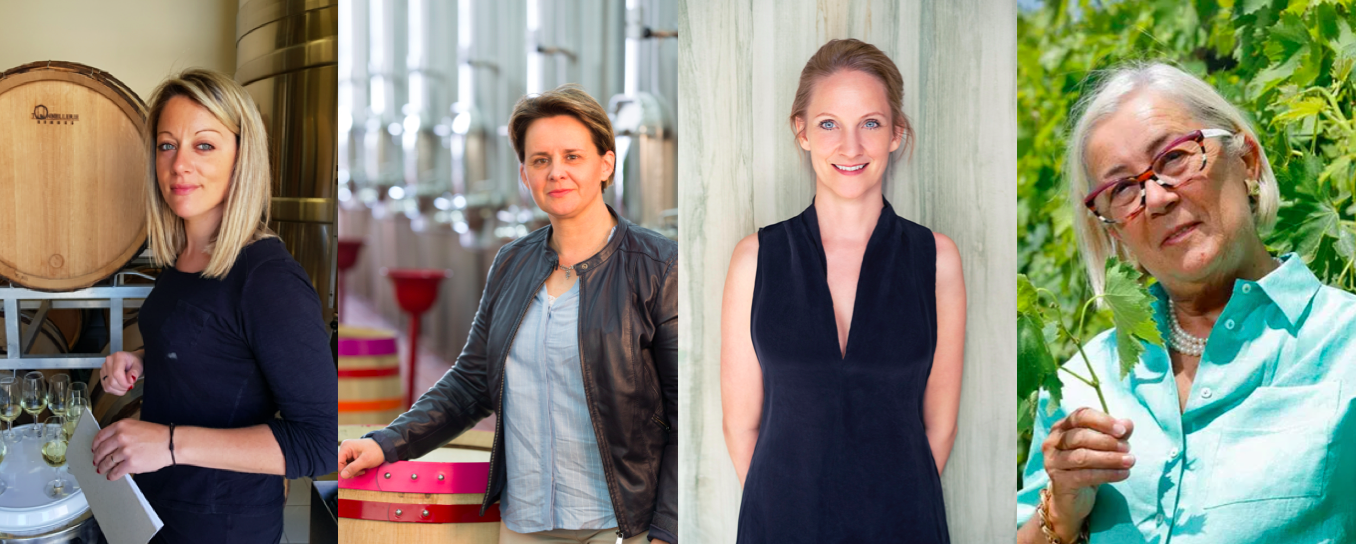 From left: Charlène Pinson, Florence Heresztyn-Mazzini, Eva Fricke, and Donatella Cinelli Colombini
From left: Charlène Pinson, Florence Heresztyn-Mazzini, Eva Fricke, and Donatella Cinelli Colombini
Charlène Pinson – Pinson
One of the longest-established families in Chablis, records show that the Pinsons have been producing in the region since 1640. Having joined her father, Laurent, at the estate in 2008, Charlène Pinson tells us of her respect for tradition and the work that her family has done before her, with the aim to “pass on the passion” to her two sons. Producing 13 different wines, she explains that each is a “reflection of their terroirs”, and are “more or less floral and fruity” depending on the slope and soil of the parcel. For those new to Pinson, she recommends the 2017 Chablis Mont de Milieu, describing it as a “pure expression of our Kimmeridgian limestones […] classic, mineral, balanced, and fresh”.
Florence Heresztyn-Mazzini – Heresztyn-Mazzini
Taking over her family’s estate (Domaine Heresztyn) in 2012, Florence Heresztyn-Mazzini and her husband, Simon Mazzini have overseen numerous developments under its new name. Introducing biodynamic practices in 2015, and achieving organic certification in 2019, Florence continues to “experiment with natural treatments” to fulfil her goal of “fighting the challenges of climate change”, including more “cover crops and sustainable pruning”. Explaining that many recent vintages have been difficult due to global warming, she tells us that she is particularly proud of her “fights” in 2013 and 2016, creating top quality wines in years that “remind us that we are small in the face of Mother Nature!”.
Eva Fricke – Eva Fricke
After making wine in Australia, Spain, and Germany, Eva Fricke returned to Germany in 2006 to start her own estate, which now holds 17ha across the Rheingau. Achieving organic certification in 2016 and membership in The Vegan Society in 2017, the property also employs several biodynamic practices including its adherence to the lunar calendar. She tells us that these principals guide her goals of developing a domain that “stands for organic, sustainable, and socially conscious standards”. Eva notes the “2019 Lorcher Schlossberg, 2019 Lorcher Krone Trocken, and 2019 Lorcher Krone Trockenbeerenauslese” as some of her top wines.
Donatella Cinelli Colombini – Casato Prime Donne and Fattoria del Colle
Born into a family of winemakers whose production in Montalcino can be traced back to 1592, Donatella Cinelli Colombini tells that it is “for this reason” that winemaking comes naturally to her. Founding Italy’s first winery run solely by women, she explains that her decision to have an all-female staff at Casato Prime Donne “leaves an imprint of acute accuracy in each step of the production process”. She notes of Casato Prime Donne wines that they are some of the first “chosen, and produced by women, for women”.
Like many of the world’s winemaking regions, Barolo is increasingly subject to dramatic weather patterns as a result of global warming. With significant frost in spring followed by an extremely hot summer, its 2017 growing season was no exception to these severe shifts. Akin to its vines, Barolo’s producers are now more than ever demonstrating their resilience to change, as evident in its latest offerings.
To guide those buying Barolo 2017 over the coming weeks, Wine Lister has spoken to nine of the region’s top producers to get a better picture of the vintage and its viticultural demands.
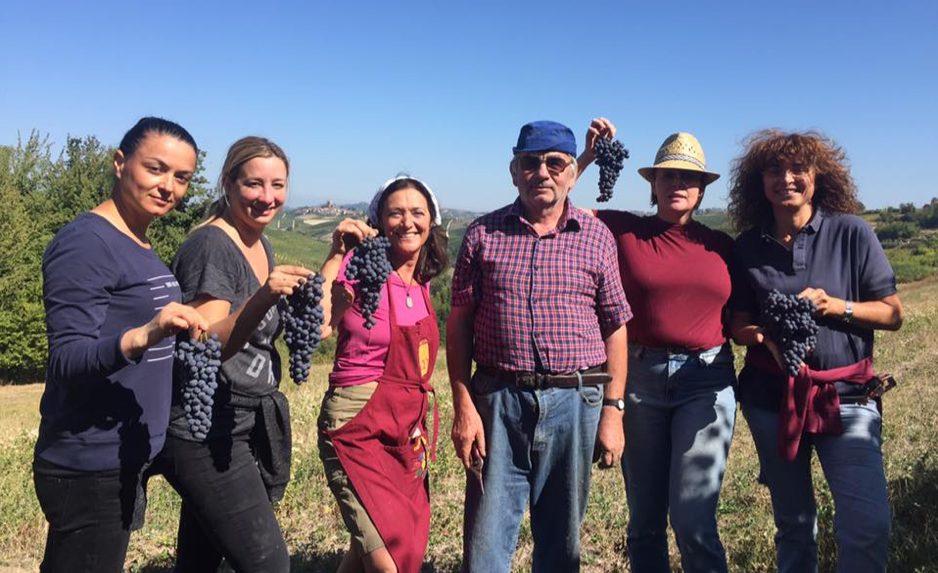 Chiara Boschis and her team during the 2017 harvest at E.Pira e Figli
Chiara Boschis and her team during the 2017 harvest at E.Pira e Figli
A reduction in production
As cited by several producers, spring frost and summer drought resulted in reduced yields across the board in 2017. Situated in the heart of Barolo, Chiara Boschis tells us that production at E.Pira e Figli was down between 10-20% on the 2016. The estate had to carefully select “clusters that were compact when picked”, as heat stress was preventing complete berry development. Marco Marengo notes that yields at his estate were 25% lower than average in 2017, while owner and winemaker at La Spinetta, Giorgio Rivetti, saw levels down by roughly 30%. A representative at Giacomo Conterno, Stephanie Flou tells us that its 2017 vintage was particularly affected by it being “the second year in a row in which [the estate] has suffered drought”. She states that while yields were limited “because the grapes dried out”, they are “positively surprised with how the vintage has ended up”.
Finding shade from the sun
Numerous estates noted the need for rigorous canopy management in 2017 – one of many adjustments applied across the region to cope with the extreme heat. Elio Altare’s second-generation winemaker, Silvia Altare tells us that hydric stress forced her to be amongst the vines, “meticulously managing the canopies to protect the grapes from the sun”. The team at Cantina Cooperativa Terre del Barolo also explain that this “was key in 2017 in order to keep bunches in shade, without suffocating them”, while “conservation tillage – mulching or grass covering in between the rows –was crucial to limit evaporation, and to protect the vines from the ‘mirror effect’ of the soil”. Vietti’s winemaker, Luca Currado notes that he similarly used “uniform, dense foliage to provide clusters with greater shade” and “grass cover between the rows to prevent sunlight reflecting directly onto the clusters”. The estate also started harvest significantly earlier than usual in 2017 – another recurring theme across the properties.
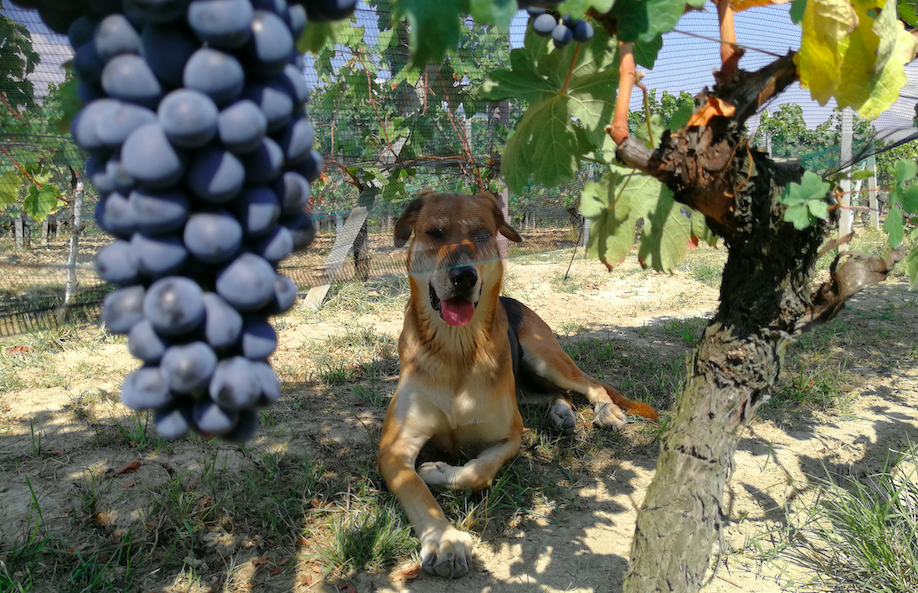 Keeping cool: the family dog at Elio Altare finds shade under the vines during the estate’s 2017 harvest
Keeping cool: the family dog at Elio Altare finds shade under the vines during the estate’s 2017 harvest
A crucial cooling
As mentioned by several of his peers, Azelia’s fifth-generation winemaker, Lorenzo Scavino tells us that a large diurnal temperature range helped to “preserve the freshness and the aromas of the grapes” in such a hot year. He states that while these cool nights “usually do not occur in warmer vintages, they were really a blessing”. Poderi Luigi Einaudi’s team echoed this sentiment, add that the temperature changes between day and night helped to develop the “polyphenolic profile of the Nebbiolo”, allowing “an excellent accumulation of tannins”. Rainfall in early September also helped to ensure balance in the 2017 vintage, with Luca Currado informing us that Vietti’s “Nebbiolo and Barbera benefited in particular, with highly complex polyphenolic profiles compared to other particularly rich vintages”, and “an unexpected freshness on the palate”.
The final freshness
Indeed, according to Wine Lister’s discussions with producers, freshness has been the great surprise of the 2017 vintage – a description applied repeatedly by Wine Lister’s partner critic, Antonio Galloni, in his notes on the region’s latest offerings. Chiara Boschis notes that E. Pira e Figli’s 2017 is “generous but very fresh”, while Azelia’s Lorenzo Scavino explains that rigorous vineyard management allowed them to “preserve the acidity, which is why even in this vintage we can find a great freshness”. Silvia Altare also tells us that while “2017 is definitely a warmer, more open knit vintage than 2016”, she has “noticed over the past few months the wines have integrated more and there’s a bit more freshness”.
The successful conception of balance in a year defined by drought aptly illustrates the resilience of Barolo’s producers in 2017, which may well be described as a winemaker’s vintage. Barolo 2017 scores have so far been high across the board, giving further merit to those who have created a wine of complexity and quality in a year of climatic uncertainty.
Keep track of new Barolo 2017 scores from Wine Lister’s partner critics here.
Home to a range of grape varieties, styles, and DOCGs, Tuscany also offers excellent wines at a variety of price points. To help you on your hunt for a top Tuscan bottle within your budget, Wine Lister has compiled a selection of Tuscany MUST BUYs at five different price points.
Click here to view all Tuscan MUST BUYs, or read more below.
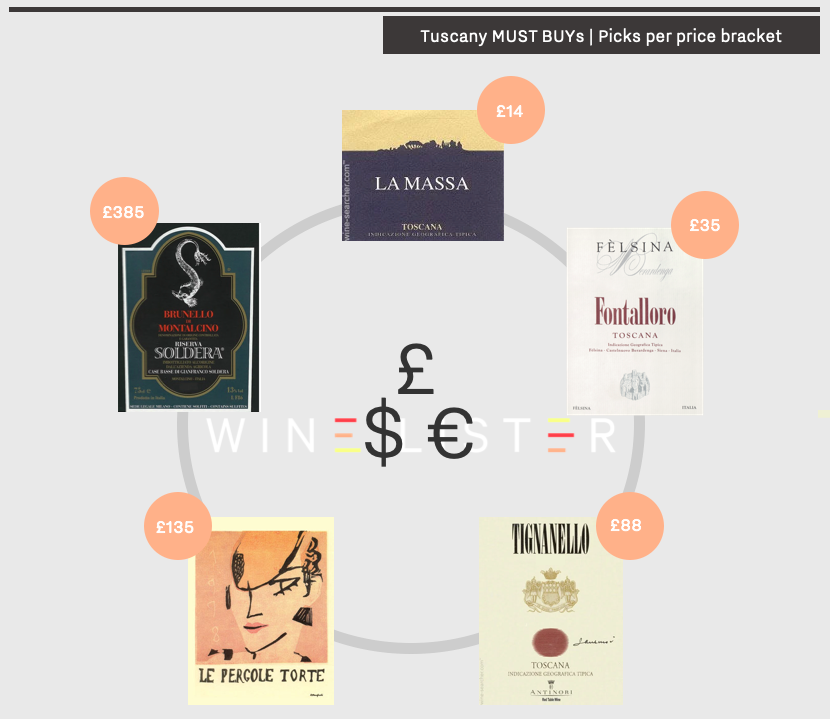 Prices are shown per bottle in-bond (when buying by the case).
Prices are shown per bottle in-bond (when buying by the case).
Under £20 – 2011 Fattoria La Massa La Massa
Founded in 1992 by prominent Chianti winemaker, Giampaolo Motta, Fattoria La Massa represents his aim of applying Bordeaux vinification techniques to a Tuscan terroir. With the counsel of famed Bordeaux vigneron, Stéphane Derenoncourt, Motta now grows Cabernet Sauvignon, Merlot, and Petit Verdot alongside native Sangiovese. La Massa comprises 60% Sangiovese, 30% Cabernet Sauvignon, and 10% Merlot in 2011, and is described by Wine Lister partner critic, Antonio Galloni as “jumping from the glass with dark red cherry, raspberry jam, plum, spices, violets, smoke and cloves”. With a WL score of 92, it is available to purchase from Bordeaux Index for £16 per bottle (in-bond).
Under £50 – 2015 Felsina Fontalloro
Felsina has seen a significant shift toward organic and biodynamic practices since its founder, Domenico Poggiali’s son-in-law, Giuseppe Mazzocolin, took over in the late 1970s. As well as investing heavily in a more natural viticulture, the estate has adopted a dedication to revealing the expression of its terroir. The 2015 Felsina Fontalloro was awarded 96 points from Antonio Galloni, who indeed notes that “sandy soils confer aromatic intensity to this super-expressive, arrestingly beautiful wine”. It can be purchased from Brunswick Fine Wines for £44 per bottle (in-bond).
Under £100 – 2016 Tenuta Tignanello Tignanello
Antinori’s Tenuta Tignanello property fared notably well in 2016, with its namesake wine, Tignanello achieving its joint-highest WL score alongside its 2015 vintage (98). Antonio Galloni describes the 2016 Tignanello as “flat out stunning”, and muses, “I don’t think there is another wine anywhere in the world made entirely from estate fruit that can match Tignanello for quality, consistency and value”. A blend of 80% Sangiovese, 15% Cabernet Sauvignon, and 5% Cabernet Franc, it can be acquired from Fine+Rare Wines for £92 per bottle (in-bond).
Under £200 – 2015 Montevertine Le Pergole Torte
Considered a difficult place for any agricultural production, Radda was an unusual location for Montevertine’s founder, Sergio Manetti to establish his property in 1967. In one of the highest and rockiest sites in Chianti Classico, its steep hills are now home to top-quality Sangiovese vines from which its three wines – Pian del Ciampolo, Montevertine, and Le Pergole – are produced. Antonio Galloni awards 97 points to the 2015 Montevertine Le Pergole Torte, calling it “deep, powerful and resonant […] exotically ripe and flamboyant, not to mention utterly captivating”. It can be bought from IG Wines for £129 per bottle (in-bond).
Over £300 – 2008 Soldera Case Basse Sangiovese
Achieving 18 points from Wine Lister’s partner critic, Jancis Robinson, Soldera’s 2008 Case Basse Sangiovese is described as “so different from most Brunello” with a “reserved nose of autumnal leaves”, and a “real tang on the end”. Having separated from the Brunello di Montalcino DOCG in 2006, all vintages from 2007 onwards are labelled as Toscana IGT. The 2008 marks a shift away from the estate’s usual vinicultural methods, having been aged for a period in stainless steel before bottling. Antonio Galloni notes that it is indeed “quite different from virtually every other wine made at Case Basse”. The 2008 Case Basse Sangiovese can be bought from Fine+Rare Wines for £387 per bottle (in-bond).
Over two years ago, Wine Lister published a blog on Tuscany’s 2018 vintage (recap here), which has since become the second most-read article on our site. With several 2018s entering the market over the past six months, and more scheduled for release this year, news of the vintage remains relevant.
To complete the picture first painted in our report on the 2018 harvest, we examine how some of the wines discussed have performed so far, and whether predictions on the vintage have come to fruition.
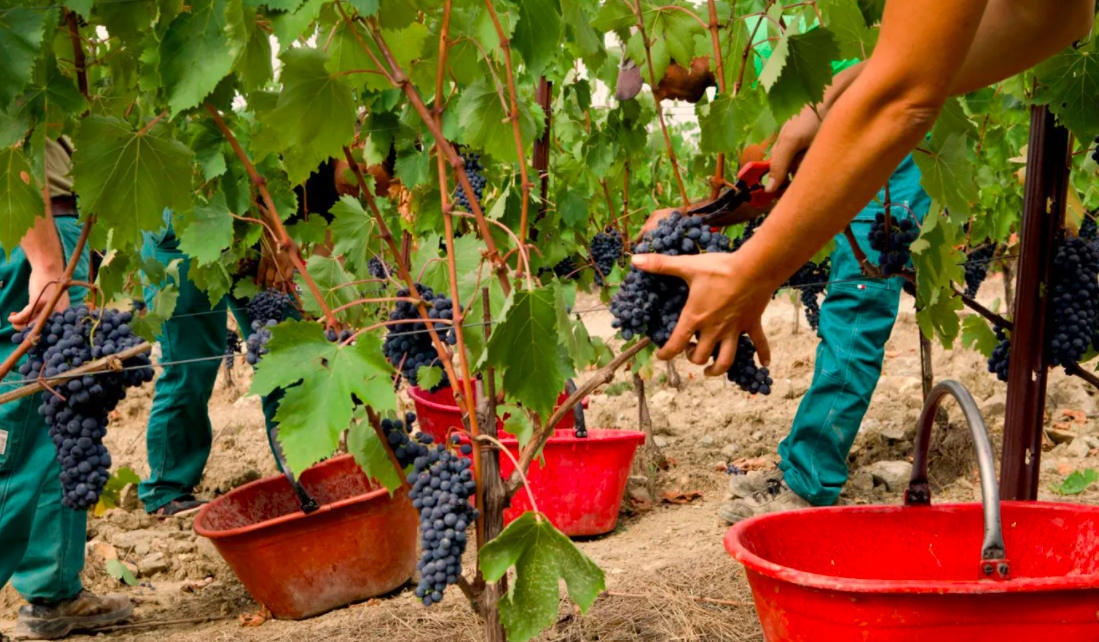 A prized picking – the 2018 harvest at Castello di Fonterutoli
A prized picking – the 2018 harvest at Castello di Fonterutoli
Predicting in 2018 that “the vintage might fall between the opulent 2015s and the structured 2016s in terms of quality and style”, Castello di Fonterutoli’s Giovanni Mazzei underestimated the year. The estate’s 50% Sangiovese and 50% Merlot blend, Siepi, achieves its highest score from Wine Lister’s partner critic, Antonio Galloni in 2018 (97) – five and two points above the 2015 and 2016, respectively. Antonio notes it is “rich, pliant and creamy”, offering “all of the seductiveness of Merlot with the bright acids and grip of Sangiovese”. The 2018 Siepi can be bought from Petersham Cellars for £70 per bottle (in-bond).
Estate Director at Ornellaia and Masseto, Axel Heinz told Wine Lister in 2018 that his “fermenting wines are silky and fragrant”, and that he predicts “a more delicate vintage”. Indeed, Antonio Galloni recently wrote on the 2018 Ornellaia that “readers should expect a silky, aromatic Ornellaia in line with vintages such as 2004 that are more about finesse than raw power”. Having been previewed by members of the fine wine trade and press in a virtual seminar last week (recap our recent blog here), it was awarded a score of 97 by Antonio. The 2018 Ornellaia will be released onto the market at the beginning of April.
Due for release through the Place de Bordeaux in September, Masseto’s 2018 vintage was the first to be made in its own winery, having previously been vinified at Ornellaia. Awarding it 98 points, Antonio notes that it is “silky, mid-weight and supremely gracious”, with notes of “inky red/purplish fruit, cedar, lavender, espresso, sage and mint”. Wine Lister sampled the second release of Masseto’s second wine, 2018 Massetino, in September 2020, and was certainly impressed by its complexity, with expressive notes of dark fruit, cocoa, and spice. While it has limited remaining market availability, it can be purchased from Cru World Wine for £307 per bottle (in-bond).
Describing 2018 as “a good year”, Fattoria Le Pupille’s owner, Elisabetta Geppetti, told Wine Lister that the Bordeaux varietals of her flagship wine, Saffredi, fared particularly well. Antonio Galloni gives it 96+ points, and writes that “the 2018 Saffredi is a regal, elegant, supremely polished wine”, which “may very well be the most refined Saffredi I have ever tasted”. Recalling notes of “sweet red cherry, plum, mocha, licorice and cinnamon”, he concludes; “don’t miss it”. It can be bought from Berry Bros & Rudd for £60 per bottle (in-bond).
Keep track of new Tuscany 2018 scores from Wine Lister partner critics here, and watch this space for future analysis on the vintage.
Last week, Wine Lister joined members of the fine wine trade and press, gathered behind their screens, for the unveiling of Ornellaia’s annual Vendemmia d’Artista collaboration. With each new vintage release, the Ornellaia team chooses a word to characterise the latest growing season and its resulting wine, and selects an artist to bring the word to life on limited-edition labels of the Ornellaia bottle.
Marking the winery’s 13th edition of Vendemmia d’Artista, the 2018 vintage has been coined “La Grazia” – Grace. Estate Director, Axel Heinz, explains that the choice of name is due to 2018 being “a wine that has no hard edges”, and one “all about symmetry, proportion…a graceful expression of Ornellaia”.
Indeed, the higher proportion of Merlot than Cabernet Sauvignon in the latest vintage blend – an exception for the estate – has produced what we found to be a soft and silky wine with a lively perfume and elegant, precise fruit. Ornellaia’s CEO, Giovanni Geddes da Filicaja, notes that the wine really came together “at the time of blending”. He adds, “all the pieces were good, but once we put them all together, it became a really gracious wine”.
That the wine should be so-named came as somewhat of a surprise to Heinz. He reveals that “it was really after the year of ageing and when we sat down in the blending room, that the wine revealed itself to us”. He describes the vintage as “one not without challenges”, expanding thus: “usually [we have] a relatively dry Mediterranean climate. In 2018 we had Mediterranean sun but at the same time enough rainfall to slow the ripening down, and create a wine that is all about balance”.
Belgian artist, Jan Fabre, was chosen to bring La Grazia to life, and limited-edition bottles in various formats will feature his work, as shown in the image below.
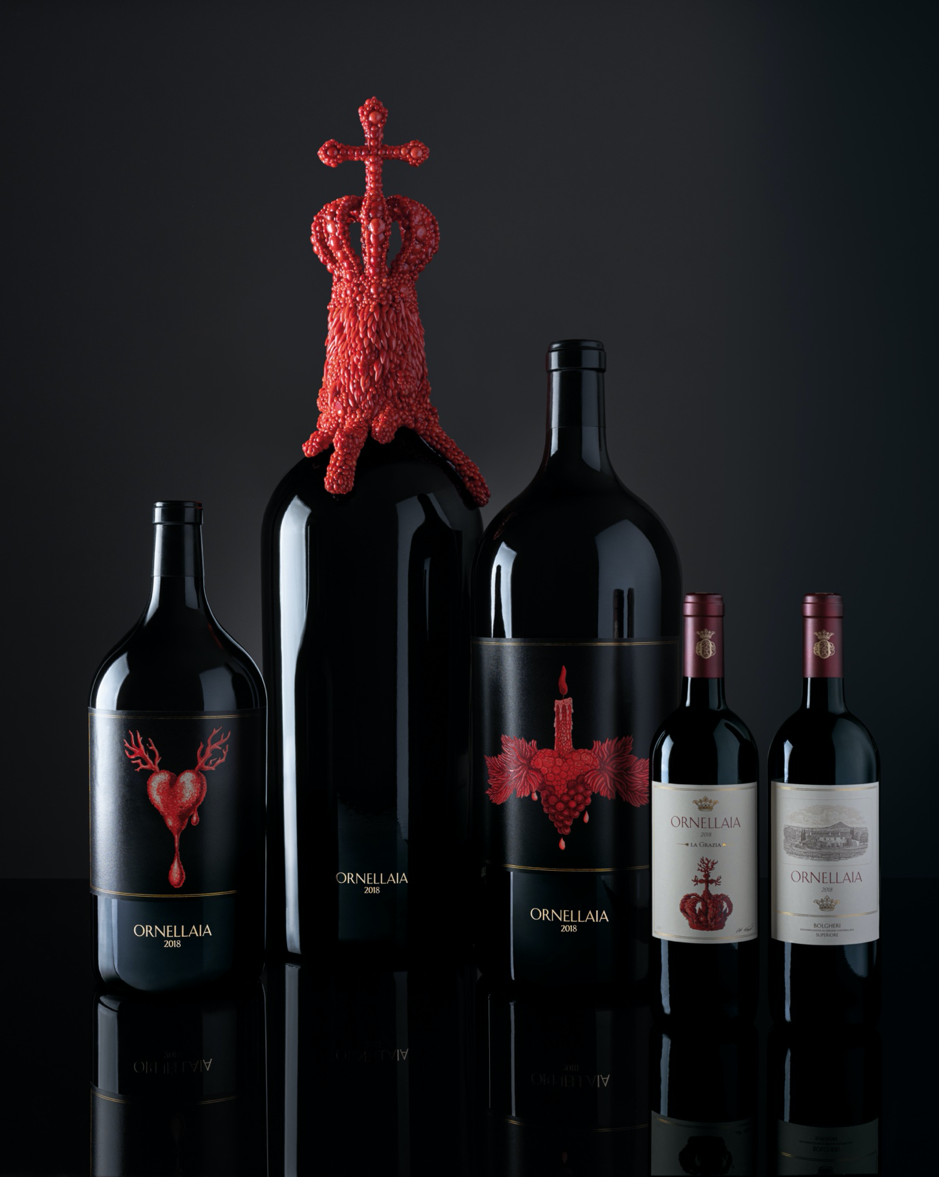 Photo: courtesy of Ornellaia winery – featuring sculpture and drawings by Jan Fabre.
Photo: courtesy of Ornellaia winery – featuring sculpture and drawings by Jan Fabre.
Ornellaia’s art curator, Bartolomeo Pietromarchi, explains the artistic concept as “a way to express balance between beauty and taste”, as well as to “explore the relationship between the senses”. Fabre has sculpted three works from precious red coral, which adorn Salmanazars due for auction in September; “A Candle of Mercy”, “The Crown of Kindness” and “The Heart of Virtue”.
Further bottles feature drawings that bring out the texture of these sculptures – indeed a limited number of 12-bottle cases of Ornellaia 2018 will each contain one bottle with Fabre’s crown label design.
The 111 limited-edition, large-format bottles will be auctioned through Sotheby’s in September 2021, and all proceeds will go towards Ornellaia’s ongoing support of the Mind’s Eye project at the Guggenheim museum.












